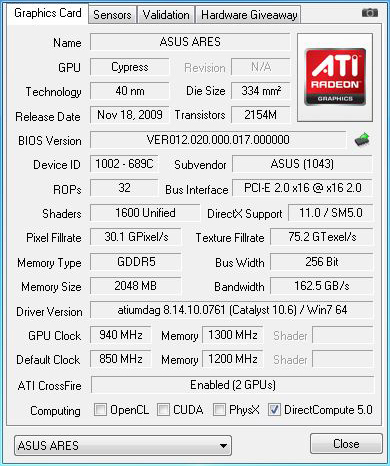Test methodology and overclocking
We've had very little time to play with ASUS's latest greatest, but in order to provide comparative numbers, we'll be pitting the ARES with the other 4GB HD 5970 contender; the Sapphire TOXIC.
We'll put both cards to the test across a number of popular PC titles at both 1,920x1,080 and 2,560x1,600 resolutions with massive amounts of image quality. All tests are conducted using AMD's most recent driver release, Catalyst 10.6, and we'll be throwing in overclocked ARES results, too.
Here are our complete system specifications, along with descriptions of our benchmark suite:
Comparison systems |
|||
|---|---|---|---|
| Graphics card | ASUS ROG ARES 4,096MB | ASUS ROG ARES 4,096MB (overclocked) | Sapphire Radeon HD 5970 TOXIC 4,096MB |
| Current pricing, including VAT | £1,199.99* | £1,199.99* | £967.74** |
| Shader model | 5.0 | 5.0 | 5.0 |
| Stream processors | 3,200 | 3,200 | 3,200 |
| GPU clock speed (MHz) | 850 | 940 | 900 |
| Shader clock speed (MHz) | 850 | 940 | 900 |
| Memory clock speed (MHz) | 4,800 | 5,200 | 4,800 |
| Memory bus width (bits) | 256 x 2 | 256 x 2 | 256 x 2 |
| Processor | Intel Core i7 965 EE (3.20GHz, 8MB L3 cache, quad-core) | Intel Core i7 965 EE (3.20GHz, 8MB L3 cache, quad-core) | Intel Core i7 965 EE (3.20GHz, 8MB L3 cache, quad-core) |
| Motherboard | ASUS P6X58D Premium Deluxe | ASUS P6X58D Premium Deluxe | ASUS P6X58D Premium Deluxe |
| Motherboard BIOS | 0808 (20/04/2010) | 0808 (20/04/2010) | 0808 (20/04/2010) |
| Memory | Corsair 6GB (3 x 2GB) DDR3 | Corsair 6GB (3 x 2GB) DDR3 | Corsair 6GB (3 x 2GB) DDR3 |
| Memory timings | 8-8-8-24-1T @ 1,066MHz | 8-8-8-24-1T @ 1,066MHz | 8-8-8-24-1T @ 1,066MHz |
| Graphics driver | Catalyst 10.6 | Catalyst 10.6 | Catalyst 10.6 |
| Disk drive | 120GB OCZ Vertex SSD | 120GB OCZ Vertex SSD | 120GB OCZ Vertex SSD |
| Optical drive | Generic 24x DVD-RW | Generic 24x DVD-RW | Generic 24x DVD-RW |
| Chassis | Corsair Obsidian Series 800D | Corsair Obsidian Series 800D | Corsair Obsidian Series 800D |
| Power supply | Corsair HX1000W | Corsair HX1000W | Corsair HX1000W |
| Operating system | Windows 7 Ultimate 64-bit | Windows 7 Ultimate 64-bit | Windows 7 Ultimate 64-bit |
GPU benchmarks |
|||
| Unigine Heaven 2.1 | DX11, 1,920x1,080, 8xAA, 16xAF, tessellation disabled, moderate, normal and extreme. | ||
| Aliens vs. Predator | DX11, 1,920x1,080 and 2,560x1,600, 4xAA, 16xAF, very high quality. | ||
| Battlefield: Bad Company 2 | DX11, 1,920x1,080 and 2,560x1,600, 8xAA, 16xAF, ultra quality, FRAPS-recorded benchmark. | ||
| Call of Duty: Modern Warfare 2 | DX9, 1,920x1,080 and 2,560x1,600, 4xAA, ultra quality, FRAPS-recorded benchmark. | ||
| Crysis Warhead | DX10, 1,920x1,080 and 2,560x1,600, 4xAA, 16xAF, enthusiast quality, Frost map | ||
| DiRT 2 | DX11, 1,920x1,080 and 2,560x1,600, 8xAA, ultra quality, London map. | ||
General benchmarks |
|||
| Temperature | To emulate real-world usage scenarios, we record GPU core temperature both when idle and whilst playing Crysis Warhead. | ||
| Power consumption | To emulate real-world usage scenarios, we record mains power draw both when idle and whilst playing Crysis Warhead. | ||
| Noise | Albeit not scientific, we use the tried-and-trusted human ear to share an opinion on GPU noise. | ||
| *estimated
retail price **price correct at the time of writing, July 8, 2010 |
|||
Overclocking

Applying a minor bump in core voltage - 1.175V to 1.2V - we were able to up the core frequency to 940MHz and the GDDR5 memory to an effective 5,200MHz.
A very healthy increase of 90MHz and 400MHz, respectively. That's enough, we should add, to outpace Sapphire's factory-overclocked TOXIC without any hint of instability.
By cranking up the voltage another notch or two, we're certain more adventurous types will be able to hit closer to 980MHz. The liquid-nitrogen crowd is certain to fly past the 1GHz mark.









